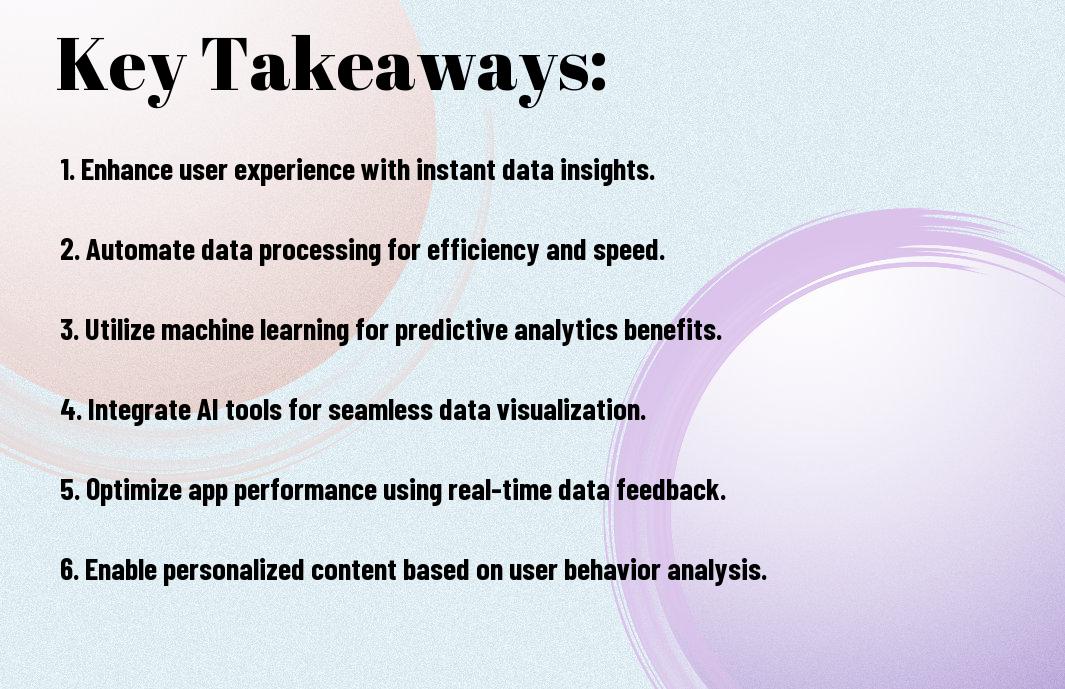You can enhance your app’s performance by integrating AI-powered real-time analytics, enabling you to make data-driven decisions. Your app generates vast amounts of data, and AI helps you process it instantly, providing valuable insights. By leveraging AI, you can analyze user behavior, track key metrics, and optimize your app for better user experience, ultimately driving your business forward with informed decisions.
Key Takeaways:
- Integrating AI into your app can significantly enhance real-time analytics capabilities, enabling faster and more accurate decision-making for users and developers alike.
- AI-powered analytics can process vast amounts of data in real-time, providing insights that might be missed through traditional analysis methods, and helping to identify trends and patterns more efficiently.
- Implementing AI-driven analytics in your app can lead to improved user experiences, as it allows for personalized content and recommendations based on user behavior and preferences.
- Real-time analytics powered by AI can also help in detecting and preventing potential issues, such as security breaches or system failures, by monitoring app performance and user activity continuously.
- To successfully leverage AI for real-time analytics, it’s necessary to choose the right tools and technologies that align with your app’s specific needs and goals, and to ensure seamless integration with existing infrastructure.

Real-Time Analytics Fundamentals
To effectively leverage AI for real-time analytics in your app, you need to understand the basics of real-time analytics, including data collection, processing, and analysis. This foundation will help you make informed decisions about your app’s performance and user behavior.
Data Stream Processing
Above all, your app’s ability to process data streams in real-time is vital for gaining timely insights. You can achieve this by utilizing technologies that handle high-volume data streams, enabling your app to respond quickly to changing user behaviors and preferences.
AI Model Integration
With the right AI models, you can unlock deeper insights into your app’s performance and user behavior. You can integrate AI models into your app to analyze real-time data, identify patterns, and make predictions about future user behavior.
Considering the complexity of AI model integration, you should focus on selecting models that align with your app’s specific needs and goals. You can choose from a variety of models, such as machine learning or deep learning, to analyze your app’s data and provide actionable insights that inform your decision-making process, helping you to optimize your app’s performance and improve user experience.

AI Components for Analytics
Now that you’re exploring AI for real-time analytics, you’ll need to understand the components involved. Your app’s analytics capabilities will rely on these components to process and analyze data efficiently.
Machine Learning Algorithms
Components such as machine learning algorithms will enable your app to learn from data and make predictions, allowing you to make informed decisions about your business.
Neural Network Applications
Around the concept of neural networks, you’ll find various applications that can enhance your app’s analytics, including image and speech recognition, natural language processing, and more.
Algorithms like deep learning and convolutional neural networks will help you unlock the full potential of your app’s neural network applications, enabling you to analyze complex data patterns and make accurate predictions about your users’ behavior.
Implementation Architecture
Many factors contribute to a successful AI-powered analytics system, and you will need to consider several components when designing your architecture, including data ingestion, processing, and storage, as well as the AI algorithms and models that will drive your analytics capabilities.
System Design Patterns
Along with choosing the right technologies, you should consider established system design patterns, such as microservices or event-driven architectures, to ensure your system is flexible, maintainable, and scalable, allowing you to adapt to changing requirements and growing demands.
Scalability Considerations
For your AI-powered analytics system to handle increasing volumes of data and user traffic, you will need to plan for scalability, considering factors such as distributed computing, load balancing, and autoscaling, to ensure your system can handle growth without compromising performance.
Another key aspect of scalability is monitoring and optimizing your system’s resource utilization, as you will need to balance the costs of infrastructure and maintenance with the need for fast and reliable analytics, and by doing so, you can ensure your system scales efficiently and effectively to meet your growing needs.
Performance Optimization
All applications require optimization to ensure seamless performance, and your app is no exception. You can leverage AI to streamline your app’s performance and provide a better user experience.
Data Pipeline Efficiency
Effectively, you can enhance your data pipeline by implementing AI-powered tools that automate data processing, reducing latency and increasing throughput, allowing you to make data-driven decisions in real-time.
Resource Management
Responsively, you can manage your resources by utilizing AI to monitor and allocate resources efficiently, ensuring that your app’s performance is not compromised, and your users have a smooth experience.
Hence, as you implement AI for resource management, you will be able to identify areas of improvement, predict potential bottlenecks, and make informed decisions to optimize your app’s performance, ultimately leading to increased user satisfaction and engagement with your app.
Security and Compliance
Keep your app’s real-time analytics secure by implementing robust measures to protect user data and ensure compliance with relevant regulations, as you integrate AI-powered analytics into your application.
Data Protection Measures
On the path to securing your app, you’ll need to implement robust data protection measures, such as encryption and access controls, to safeguard sensitive user information and maintain trust in your brand.
Regulatory Requirements
Across various jurisdictions, you must comply with a range of regulatory requirements, including data protection laws and industry standards, to avoid penalties and reputational damage.
The specifics of these regulatory requirements will depend on your app’s target market and the type of data you collect, so you’ll need to carefully assess your obligations and develop a compliance strategy that meets your unique needs, ensuring that your use of AI for real-time analytics aligns with relevant laws and regulations, and that you’re transparent with your users about how their data is being used.
Monitoring and Maintenance
Unlike traditional analytics methods, AI-powered real-time analytics requires continuous oversight to ensure optimal performance, allowing you to identify and address issues promptly, thereby maximizing your app’s potential.
System Health Tracking
Beneath the surface of your app’s interface, you need to track system health to prevent downtime and data loss, enabling you to take proactive measures to maintain your app’s stability and performance.
Model Performance Updates
The key to successful AI implementation lies in regularly updating your models to adapt to changing user behavior and preferences, allowing you to refine your app’s analytics and decision-making capabilities.
Monitoring your model’s performance over time, you will be able to identify areas for improvement, update your training data, and retrain your models to ensure they continue to provide accurate and relevant insights, enabling you to make informed decisions about your app’s development and growth, and ultimately enhancing your users’ experience.
Summing up
As a reminder, you can significantly enhance your app’s capabilities by leveraging AI for real-time analytics. You will be able to make data-driven decisions, improving your app’s overall performance and user experience. By integrating AI-powered analytics, you can gain valuable insights into your users’ behavior, allowing you to optimize your app and stay ahead of the competition, ultimately driving your business forward with informed decisions based on real-time data analysis.
FAQ
Q: What are the benefits of integrating AI-powered real-time analytics in my mobile or web application?
A: Integrating AI-powered real-time analytics in your application can significantly enhance user experience by providing instant insights and personalized recommendations. It enables businesses to make data-driven decisions, optimize operations, and improve customer engagement. With real-time analytics, you can track user behavior, identify trends, and respond promptly to changes in the market or user preferences, ultimately leading to increased conversion rates and revenue growth.
Q: How can I ensure the accuracy and reliability of AI-driven real-time analytics in my app?
A: To ensure the accuracy and reliability of AI-driven real-time analytics, it’s important to implement a robust data validation process, utilize high-quality data sources, and continuously monitor the performance of your AI models. Regularly updating and refining your models with new data and feedback from users can also help maintain their accuracy over time. Additionally, leveraging techniques such as data normalization, feature engineering, and cross-validation can further enhance the reliability of your analytics.
Q: What are the key considerations for implementing AI for real-time analytics in my app, especially concerning data privacy and security?
A: When implementing AI for real-time analytics, it’s vital to prioritize data privacy and security. Ensure that you comply with relevant regulations such as GDPR or CCPA by obtaining explicit user consent for data collection and processing. Implement robust data encryption methods to protect user data both in transit and at rest. Furthermore, use secure authentication and authorization protocols to control access to sensitive data and analytics insights. Transparency about what data is collected and how it’s used is also key to building trust with your users.



